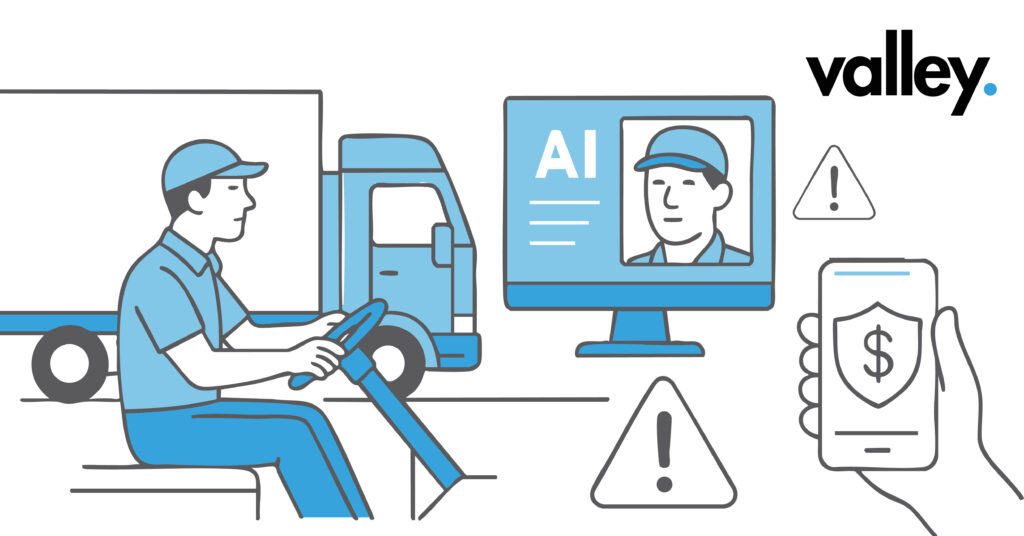Deepfakes in Trucking: How AI Image Generation Could Fuel Fraud

Fraud in trucking is evolving, and AI is making it more dangerous. In 2025, criminals are no longer satisfied with simple forged documents or staged accidents. Deepfake image and video tools now let them create fake visual evidence that can trick fleets, insurers, and shippers. Without stronger defenses, companies could face new waves of costly, hard-to-detect fraud.
Quick Answer
Deepfakes let fraudsters generate or tamper with visual evidence such as fake damage photos, synthetic driver IDs, or falsified CCTV frames. In trucking, this can enable bogus claims, phantom carriers, or manipulated deliveries. The best protection includes multi-modal checks, AI detection technology, and secure identity onboarding.
Why This Issue Matters
Trucking depends heavily on photos, videos, and visual proof. Damage claims, delivery evidence, and driver identification all rely on images. When those images can be faked or altered, the integrity of the entire chain is at risk.
According to FreightWaves, generative AI is already supercharging fraud in freight. Insurance experts at Verisk report rising cases of “digital media fraud” in claims. The U.S. DOT is also exploring AI tools to strengthen carrier identity enforcement to stop fraud at the source.
How Deepfake Fraud Works in Trucking
Synthetically Generated Damage Claims
Fraudsters can create entirely fake damage images or overlay damage onto intact trucks. These images may pass initial visual inspection. Law firm Swift Currie explains that AI could fabricate accidents to exploit insurance systems. Verisk also warns about manipulated or reused images undermining trust in claims.
False Driver IDs and Impersonation
A deepfake can generate a convincing portrait of someone who never existed or swap a face into a license photo. That gives fraudsters a way to bypass identity checks. Combined with voice cloning or live video deepfakes, it creates “drivers” who only exist in AI. Steptoe reports that audio and video deepfakes are already being used in scams across industries.
Fabricated Cargo or Condition Photos
Before-and-after photos of cargo, seals, or truck interiors can be tampered with. A fraudster might generate a “clean” image to hide damage or theft. Generative AI tools can erase or add details invisibly.
Fake Documents, Permits, and Carrier Identity
AI can produce fake inspection reports, carrier permits, or DOT filings that look authentic. Fraud experts told CDLLife that weak carrier identity checks allow bogus fleets to register and commit fraud.
Hybrid Scams: Deepfake + Social Engineering
A deepfake video or audio call can impersonate a dispatcher, executive, or adjuster. Paired with fake visuals, this can be used to request fund transfers or validate fraudulent claims. In one case, The Guardian reported that engineering firm Arup lost £20 million in a deepfake scam. Business Insider also covered how cheap AI voice clones are already fooling banks.
Real-World Scenarios
- Landstar Freight – Trucking Dive reported that Landstar has faced fraud challenges and is investing in new ways to counter AI threats.
- Generative AI Alerts – Yahoo News highlighted how AI-based fraud could overwhelm existing defenses if not addressed.
- Insurance Industry – Transport Topics noted that insurers are redesigning underwriting and detection to deal with digital fraud.
The Impact on Companies
- Financial losses from fake claims, invoices, or deliveries
- Higher insurance costs with stricter terms and premiums
- Operational delays caused by disputes over fraud
- Reputational harm when clients lose trust
- Legal and regulatory risks from weak fraud controls
Common Mistakes Companies Make
- Relying on a single image without checking metadata or context
- Ignoring anomalies in timestamps, geotags, or photo reuse
- Weak driver or carrier onboarding
- No fraud analytics to flag suspicious patterns
- Working in isolation instead of sharing fraud intelligence
How the Industry Can Respond
1. Multi-Modal Verification
Combine visual checks with GPS data, telematics, liveness video tests, and biometric scans.
2. AI Detection Tools
Deploy forensic systems that detect manipulation artifacts. Research such as this study on image forgery detection shows how deep learning can improve accuracy.
3. Digital Watermarking
Use cryptographic signatures or invisible watermarks to prove content authenticity.
4. Anomaly Analytics
Monitor claims and deliveries for unusual patterns like repetitive images or sudden spikes in submissions.
5. Stronger Onboarding
Require video interviews, biometrics, and government database checks for new drivers or carriers.
6. Collaboration Across Industry
Share intelligence with fleets, insurers, and regulators to spot trends early.
7. Regulatory Push
Governments are considering rules for AI provenance. CyberScoop reported on new bills targeting deepfake fraud, while Reuters covered UN recommendations for global standards.
FAQs
Can AI detection tools catch deepfakes?
- They are improving but not perfect. Best practice is to combine them with metadata and cross-checks.
Does GPS or metadata guarantee authenticity?
- No. Metadata can be faked. Always verify against independent logs.
Do deepfakes only affect large fleets?
- No. Smaller carriers and brokers are also vulnerable, especially in spot markets.
Is deepfake fraud cheap to create?
- Yes. Modern tools make it fast and inexpensive, lowering the barrier for criminals.
What red flags should fleets watch for?
- Repeated image angles, mismatched lighting, missing metadata, or no supporting evidence.
How urgent is action?
- Very urgent. Fraud tactics evolve quickly, and delays give criminals an advantage.
Final Thoughts
Deepfakes and AI-generated images are no longer future concerns, they are active threats in trucking today. Fraudsters can fake damage, impersonate drivers, and fabricate documents at scale. Companies that fail to adapt could face financial losses, regulatory trouble, and broken trust with clients. The best response is a layered defense. Use AI detection, digital watermarking, strong identity verification, anomaly analytics, and industry cooperation.
